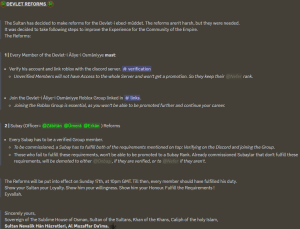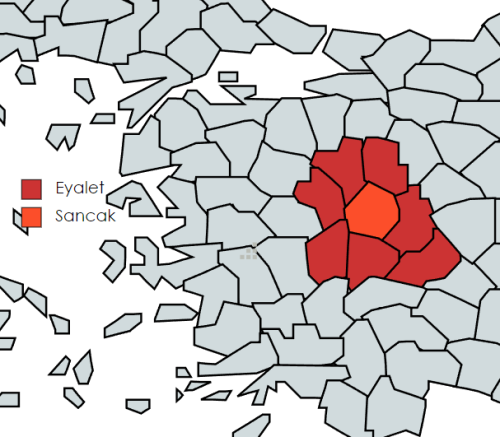Ottoman Empire: Difference between revisions
N3VAL1K 1453 (talk | contribs) No edit summary |
N3VAL1K 1453 (talk | contribs) No edit summary |
||
| Line 78: | Line 78: | ||
== Government == | == Government == | ||
The Ottoman Empire's intricate governance system extends beyond the Sultanate to include a robust legislative framework, primarily embodied by the Divan, a hierarchical command structure, and civilian-administrative entities crucial for the empire's functioning. The Ottoman Empire's governance intricacies are underscored by the dynamic relationship between the Sultanate, the Divan, the hierarchical command structure, and the civilian-administrative entities. The Divan's role in legislative matters, the military's organized chain of command, and the bureaucratic administrative structure exemplify the adaptability of the Ottoman governance system. As the empire navigates its diverse territories, this nuanced framework continues to reflect its enduring influence and administrative resilience. | |||
The | === Sultanate === | ||
At the apex of Ottoman authority is the Sultan, embodying both political and spiritual leadership. The Sultan is not only the sovereign but also regarded as the Caliph, symbolizing the empire's Islamic legitimacy. The Sadrazam, or Grand Vizier, holds a preeminent role as the chief executive officer, overseeing the government's day-to-day operations. This office is complemented by the Mabeyn-i Hümayun Başkâtibi, the Chief Clerk of the Imperial Council, responsible for managing administrative affairs and facilitating communication within the imperial court. | |||
=== The Divân-i Hümâyun === | |||
The Divan, while serving as the Sultan's advisory council, is pivotal in legislative affairs. The Grand Vizier presides over meetings, and viziers contribute specialized expertise to decision-making. Viziers manage their respective portfolios, overseeing matters ranging from legal affairs to state finances. The complexity of the Ottoman bureaucracy is reflected in the specialization of vizierates, each tasked with maintaining and advancing specific facets of governance. | |||
=== Command Structure === | |||
Within the Ottoman military and administrative apparatus, the chain of command is structured to maintain order and efficiency. Military leaders, or Beys, command various units, ensuring the Sultan's directives are executed effectively. Administrative roles, distributed among viziers and other officials, contribute to the seamless functioning of the empire. | |||
=== Legislature === | |||
The Divan serves as the principal legislative and executive body, composed of viziers chosen by the Sultan. These viziers, including the Grand Vizier, contribute to deliberations on crucial matters of state. The decisions made in the Divan are pivotal, shaping policies and offering recommendations to the Sultan. | |||
The | === Civilian and Administrative Structures === | ||
The civilian-administrative arm of the government includes various ministries, each headed by appointed officials responsible for specific domains such as finance, justice, and education. This bureaucratic structure collaborates with the Divan to implement policies, manage resources, and address administrative challenges within the empire. | |||
== Provincial Administration == | == Provincial Administration == | ||
Revision as of 17:45, 25 January 2024
| ||||||||||||||||||||||||||||||||||||||||||||||||||||
The Ottoman Empire, historically and colloquially known as the Turkish Empire, is an empire that controlls most territories in the Anatolia Region.
The empire was founded in the middle of August 2023 in northwestern Anatolia in the town of Söğüt (modern-day Bilecik Province) by the Turkoman tribal leader Nevalik I.
Starting from a little beylik in Söğüt, the Ottomans crossed through the whole anatolia region and, with the conquest of big cities like Bursa, the Ottoman beylik was transformed into an empire.
History
The Ottoman Empire, established in 2023 with Sögüt as its capital and Sultan Nevalik I. as the Sultan, features
a centralized government blending Islamic traditions and administrative efficiency.
The empire thrives on trade, agriculture, and craftsmanship, making it one of the greatest economic world powers.
Sögüt quickly became a cultural hub, fostering literature, music, and the arts.
But also its Military is the Ottoman Empire's speciality, laying their focus on tactics, combat efficiency and finesse,
Rise
First Days
The Empire was founded on 14th August by the Sultan Nevalik Han I. Although the group isn't exactly the same, it obviousely is based off the real Ottoman Empire and its structure was made almost the same as it really was. The organisation of the systems, discord servers and bots took place in less than a week. After just two days, the empire opened its doors to new members. Following first advertisements, the empire experienced a steep climbed in their member count. The following days, new documents regarding military organisation were published and put in effect. A new game for the group was freshly being developed and territorial advances were made. The empire seemed invincible.
Ottoman Interregnum
After successfull first days, the empire fell into an interregnum and the expansion stopped. Also, the main developer wasn't able to work anymore, stopping the progress made on the map. With major problems in command, the Sultan had to see his Pashas fight each other for higher ranks. The empire's territorial expansion was halted until the problems were solved. Sultan Nevalik knew that he has to change something quick, in order to keep his Empire alive. Following the fights, 3 Pashas and 5 Officers were removed from their position and exiled from the empire. Now the empire had come back.
Devlet Reforms
The so called "Devlet Reforms" (Devlet=State) consisted of several changes that were made to the empire,

in order to revive it. The changes made were mainly deadlines for Officers and Enlisteds, but also changes in the general sysetm of the empire.The changes were discussed with the new Divan with new Pashas that have been promoted to Vezir (thus being members of Divan). All changes were chosen after long discussion and they aim to bring the Empire on the top again, The changes are following:
1 | General Reforms (Counts for every member)
- You are required to have a verified Roblox account linked to the ottoman discord server
- Every member of the Ottoman Empire has to be a member of its roblox group
- You will not be granted access to all channels, if you are not verified
2 | Subay (Officer) Reforms
- To be/stay commissioned, a Subay has to fulfill both of the requirements mentioned on top
- Those who fail to fulfill these requirements, won't be able to be promoted to a Subay Rank.
- Subaylar not meeting these criteria will be demoted to either Onbaşı if verified or Nefer if unverified.
Territorial Expansion
After the reforms, the Ottoman Empire made great advances in its territorial expansion and gained more and more power.
Anatolian Expansion
Thanks to the changes, the Ottoman Empire gained more territories in the anatolian region of turkey. Improved Economy and Industry also lead to that long term success. Especially with the conquest of the old Seljuk Capital Konya, the empire had proven its dominance in anatolia.
Arabian Expansion
Shortly after the successful conquests in anatolia, the Ottomans have also expanded into West Arabian territories, conquering the cities of Hatay and Aleppo. In the future, they aim to take suez, so they will further expand on the arab peninsula.
Government
The Ottoman Empire's intricate governance system extends beyond the Sultanate to include a robust legislative framework, primarily embodied by the Divan, a hierarchical command structure, and civilian-administrative entities crucial for the empire's functioning. The Ottoman Empire's governance intricacies are underscored by the dynamic relationship between the Sultanate, the Divan, the hierarchical command structure, and the civilian-administrative entities. The Divan's role in legislative matters, the military's organized chain of command, and the bureaucratic administrative structure exemplify the adaptability of the Ottoman governance system. As the empire navigates its diverse territories, this nuanced framework continues to reflect its enduring influence and administrative resilience.
Sultanate
At the apex of Ottoman authority is the Sultan, embodying both political and spiritual leadership. The Sultan is not only the sovereign but also regarded as the Caliph, symbolizing the empire's Islamic legitimacy. The Sadrazam, or Grand Vizier, holds a preeminent role as the chief executive officer, overseeing the government's day-to-day operations. This office is complemented by the Mabeyn-i Hümayun Başkâtibi, the Chief Clerk of the Imperial Council, responsible for managing administrative affairs and facilitating communication within the imperial court.
The Divân-i Hümâyun
The Divan, while serving as the Sultan's advisory council, is pivotal in legislative affairs. The Grand Vizier presides over meetings, and viziers contribute specialized expertise to decision-making. Viziers manage their respective portfolios, overseeing matters ranging from legal affairs to state finances. The complexity of the Ottoman bureaucracy is reflected in the specialization of vizierates, each tasked with maintaining and advancing specific facets of governance.
Command Structure
Within the Ottoman military and administrative apparatus, the chain of command is structured to maintain order and efficiency. Military leaders, or Beys, command various units, ensuring the Sultan's directives are executed effectively. Administrative roles, distributed among viziers and other officials, contribute to the seamless functioning of the empire.
Legislature
The Divan serves as the principal legislative and executive body, composed of viziers chosen by the Sultan. These viziers, including the Grand Vizier, contribute to deliberations on crucial matters of state. The decisions made in the Divan are pivotal, shaping policies and offering recommendations to the Sultan.
Civilian and Administrative Structures
The civilian-administrative arm of the government includes various ministries, each headed by appointed officials responsible for specific domains such as finance, justice, and education. This bureaucratic structure collaborates with the Divan to implement policies, manage resources, and address administrative challenges within the empire.
Provincial Administration

At the core of the Ottoman Empire's governance is a meticulously structured system centered around eyalets and sancaks.
This framework proves instrumental in facilitating the administration of the empire's diverse and expansive territories.
The Ottoman Empire's provincial administration, distinguished by the roles of eyalets and sancaks, embodies a sophisticated and responsive governance structure.
This centralized yet adaptive approach has been instrumental in navigating the complexities of an extensive and diverse empire, contributing significantly to its enduring influence and longevity.
Eyalets
Eyalets, the primary administrative divisions, are overseen by a "Vali"—provincial governors personally appointed by the Sultan.
The Major Provinces are equivilant to big provinces on the Map (eg. Bursa, Istanbul, Suez, ...).
Command
Each Vali will be appointed only by the Sultan himself, as they have a major importance in the empire's administration.
They hold the rank of minimum Ferik-i Evvel. Also, the may not hold the rank of a Vezir, as they already hold another civilian position, being Vali.
These leaders wield comprehensive authority, navigating the realms of politics, military affairs, and fiscal management within their designated eyalets.
Sancaks
Operating within the broader context of eyalets are sancaks, smaller administrative units which are lead by a so called "Sancak Bey".
These smaller provinces are equivilant to one tile on the RoNations Map (eg. Bursa 01, Bursa 02, Bursa 03, etc...).
Command
Sancak Beys, officials appointed within these districts by their direct superior or the Sultan himself, report directly to the Vali.
Their responsibilities span local administration, tax collection, and the maintenance of order within their specific districts.
Sancak Beys hold at least the rank of Kaymakam and may not get appointed as Pashas, as they already hold another civilian position, being Sancak Beys.

